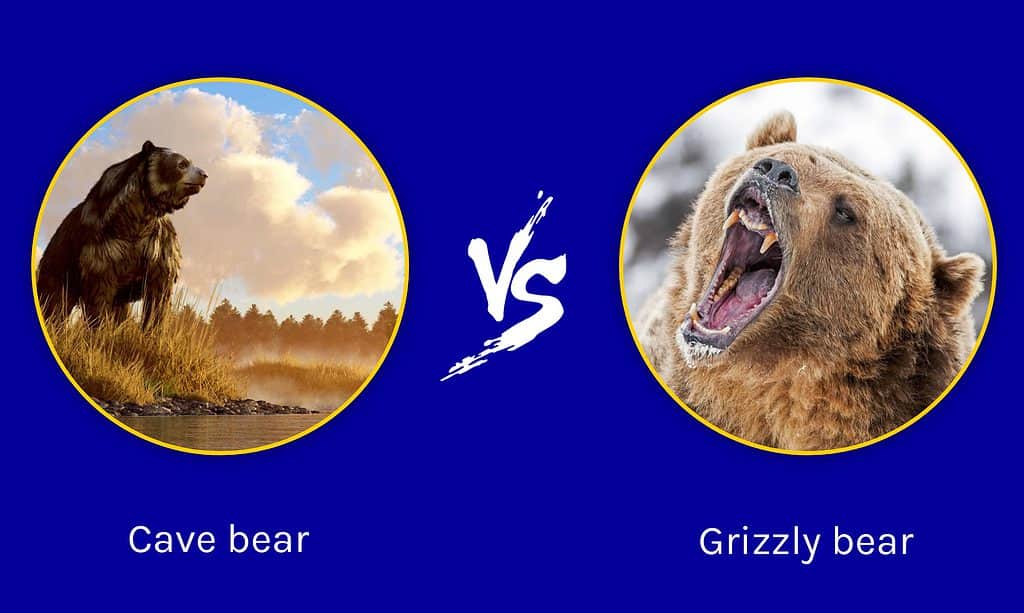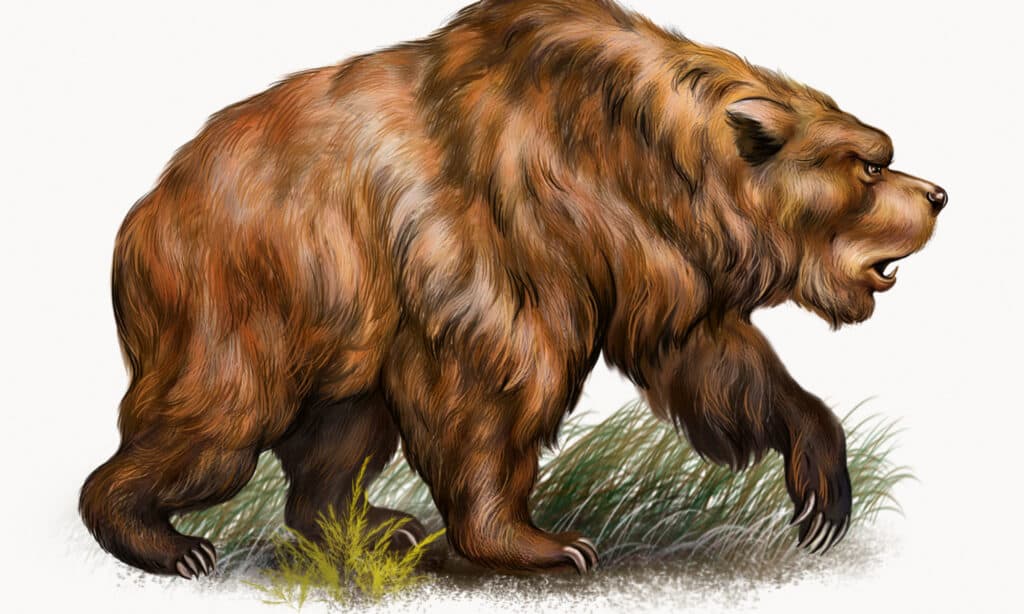Grizzly bears are large, scary mammals that can take down prey even larger than themselves. The polar bear is probably the only member of the species that people fear more. That’s in the modern day, though. Although a grizzly bear could fight off many other species of bears these days, how would it fare against a large one from the past? We will examine a hypothetical cave bear vs grizzly bear fight and see which animal will win.
We’ll do this by comparing various facets of each animal to see where they are superior or weaker than the other. Let’s start by performing a quick evaluation of the two animals.
Comparing a Cave Bear and a Grizzly Bear

| Cave Bear | Grizzly Bear | |
|---|---|---|
| Size | Weight: averaged 770 to 1,320 pounds, with a max weight of around 2,200 pounds. Height: between 4 and 5 feet tall at the shoulder on all fours Length: about 6.6 feet long or more | Weight: 300 to 800 pounds, but the largest one weighed up to 1,600 pounds Height: often between 3 and 3.5 feet tall, but large specimens stand 4 feet tall or more Length: usually between 4 and 6 feet, but the large grizzlies can grow upwards of 8 feet long |
| Speed | – Unknown top speed | – Has a top running speed of 35 mph, but it can’t maintain that speed for long – Has enough speed and endurance to chase down deer |
| Defenses | – Massive size would scare away most creatures – Large body would be difficult to damage and kill – Ability to stand on its hind feet reduces potential attacks to its head | – Status as an apex predator means few animals are willing to fight it – Thick fur and fat layers protect the bear from many attacks – Hunting senses would let the bear detect another creature from far away – Standing makes their heads less vulnerable |
| Offensive Capabilities | – Had teeth that measured between 1 and 1.5 inches long – Claws measured about 2 inches long – Unknown bite power, but they were mostly herbivorous – May have been able to maul its foes | – Bite power of about 975 PSI – Canine teeth measure about 3 inches long – Other teeth measure about 1 inch long – Have somewhat dull claws used for digging that measure several inches in length – Can slash, bite, use their weight, or shake prey to kill it |
| Predatory Behavior | – Primarily herbivorous – May have scavenged meat – Lion bodies in their caves suggest cave bears were competent fighters | – Omnivores that prefer to gather food or scavenge than hunt – Capable of using endurance predation to bring down large animals |
What Are the Key Differences Between a Cave Bear and a Grizzly Bear?
The greatest differences between a cave bear and a grizzly bear are their size and predatory behavior. The cave bear was larger than the grizzly bear, weighing up to 2,200 pounds, while most grizzly bears weigh under 1,000 pounds. Moreover, the average cave bear was between 4 and 5 feet at the shoulder, while most grizzly bears are about 3 to 3.5 feet tall at the shoulder.
The cave bear was almost entirely herbivorous, so it didn’t have much in the way of predatory behavior. Yet, it did scavenge meat, possibly from its species. Meanwhile, grizzly bears are primarily gatherers and scavengers, but they can use endurance predation to catch and kill their prey.
These are the biggest differences between these two animals, but we need more information to determine which one would win this fight.
What Are the Key Factors in a Fight Between a Cave Bear and a Grizzly Bear?
Most fights in the wild come down to five factors; size, speed, offensive powers, predatory abilities, and defenses. We’re going to compare the two bears in terms of each quality, figure out which of them is superior, and then use the collective knowledge we gain to determine which creature would probably win this hypothetical fight.
Cave Bear vs. Grizzly Bear: Size

The cave bear had the size advantage over the grizzly bear.
©Liliya Butenko/Shutterstock.com
The cave bear was much larger than a grizzly bear. The average cave bear could weigh between 770 and 1,320 pounds, but larger specimens grew up to 2,200 pounds! They could stand between 4 and 5 feet at the shoulder when walking on all fours, and they could grow from 6.6 feet long to much longer.
Meanwhile, the average grizzly bear weighs about 300 to 800 pounds, with the largest ones weighing up to 1,600 pounds. On average, they stand about 3 to 3.5 feet tall and grow between 4 and 6 feet long, up to about 8 feet.
The cave bear has the size advantage.
Cave Bear vs. Grizzly Bear: Speed

Grizzly bears have a top speed of 35 mph.
©Scott E Read/Shutterstock.com
Sadly, we don’t have any accurate records of the cave bear’s speed. Given its size, though, it may not have been able to run as quickly as a grizzly bear. The grizzly bear can run at a top speed of 35 mph, which ensures most prey won’t get away from them.
The grizzly bear has the speed advantage.
Cave Bear vs. Grizzly Bear: Defenses
Both the cave bear and the grizzly bear would rely on their size to keep them safe from other animals. Some evidence suggests that the cave bear fought off and killed lions in their dens. Despite being mostly herbivorous, the cave bear could use its size and strength to kill predators.
Aside from their size, both the cave bear and the grizzly bear stand on their hind legs, making their head hard to strike and giving them the ability to come crashing down on shorter animals.
The thick fur and fat on these creatures would make it hard for others to deal significant damage to them unless they were packing some serious offensive weapons.
Since the cave bear was larger and the two creatures depended on their size to keep them safe in a fight, the cave bear has the advantage.
Cave Bear vs. Grizzly Bear: Offensive Capabilities
The grizzly bear may be an omnivore, but it has the ability to hunt large animals. Aside from the bear’s speed, it has a bite force of around 975 PSI and 3-inch-long canine teeth to use while attacking. The rest of their teeth average about 1 inch in length. Their powerful bite is not all their foes need to worry about, though.
Grizzly bears also have claws that measure over 3 inches in length that they can use for slashing their prey. When they attack prey, though, grizzlies prefer to use a multi-faceted mauling attack. While mauling, they can use their claws, bites, shakes, smacks, and body weight to tire out and kill their prey.
We don’t know much about how cave bears fought. They only had teeth that measured about 1 to 1.5 inches at most, about half the size of a grizzly’s. Their claws were about 2 inches long, too. It’s likely that they would maul attackers even though they were primarily herbivorous. They’d need to bite, claw, and simply overwhelm other animals using their weight to be successful.
Grizzly bears have more offensive power, so they have the advantage in this case.
Cave Bear vs. Grizzly Bear: Predatory Behavior
Evidence shows that the cave bear probably didn’t hunt other animals, but it was not above scavenging their meat. So, their predatory behavior was minimalistic. Grizzly bears are somewhat similar in that they would rather find a meal than chase it down.
Yet, that doesn’t mean the grizzly bear doesn’t successfully hunt other creatures. They use endurance predation to chase down their larger prey, deliver multiple bites, and then eventually kill the creature once it’s too tired to fight back. They can simply kill small prey, like salmon, with a single bite.
Grizzly bears have the advantage of predatory behavior.
Who Would Win in a Fight Between a Cave Bear and a Grizzly Bear?

The grizzly bear would win a fight against a cave bear.
©Steve Boice/Shutterstock.com
A grizzly bear would win a fight against a cave bear. The cave bear is bigger than the grizzly bear, but that’s all it has going for it. The grizzly bear has better predatory instincts, larger teeth, larger claws, experience fighting and killing other creatures, and enough size to take down prey that is their size or larger.
The fight could begin simply enough, with a grizzly bear and a cave bear meeting while pursuing the scent of a meal. The grizzly bear would charge into battle to get the cave bear to back off, realizing too late that it was much larger than it.
The grizzly bear would rear up into its threat display, the same as the cave bear. Unwilling to budge, the fight would begin. The grizzly bear and cave bear would vie for each other’s necks. The faster grizzly bear would get the first attack, landing a vicious bite and tearing at its foe.
Meanwhile, the cave bear would swat and claw the grizzly bear, and the battle would devolve into a flurry of bites, claws, and attempts to use their weight to overwhelm their opponents.
Eventually, both animals would take some wounds, and the herbivorous cave bear would realize that it doesn’t need to keep taking the more powerful grizzly bites. The cave bear would bow out of this fight, leaving the grizzly to win.
Given the grizzly bear’s propensity for violence and the cave bear’s lack of experience attacking other animals, it seems more likely that the smaller creature actually wins a fight for once!
Up Next:
- Epic Battles: Grizzly Bear vs. Rhino
- Epic Battles: Grizzly Bear vs. Lion
- Epic Battles: Grizzly Bear vs. Jaguar
- Epic Battles: Grizzly Bear vs. Terror Bird
- Epic Battles: Grizzly Bear vs. Irish Elk
The photo featured at the top of this post is ©
Thank you for reading! Have some feedback for us? Contact the AZ Animals editorial team.






